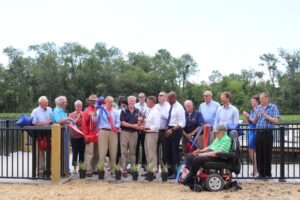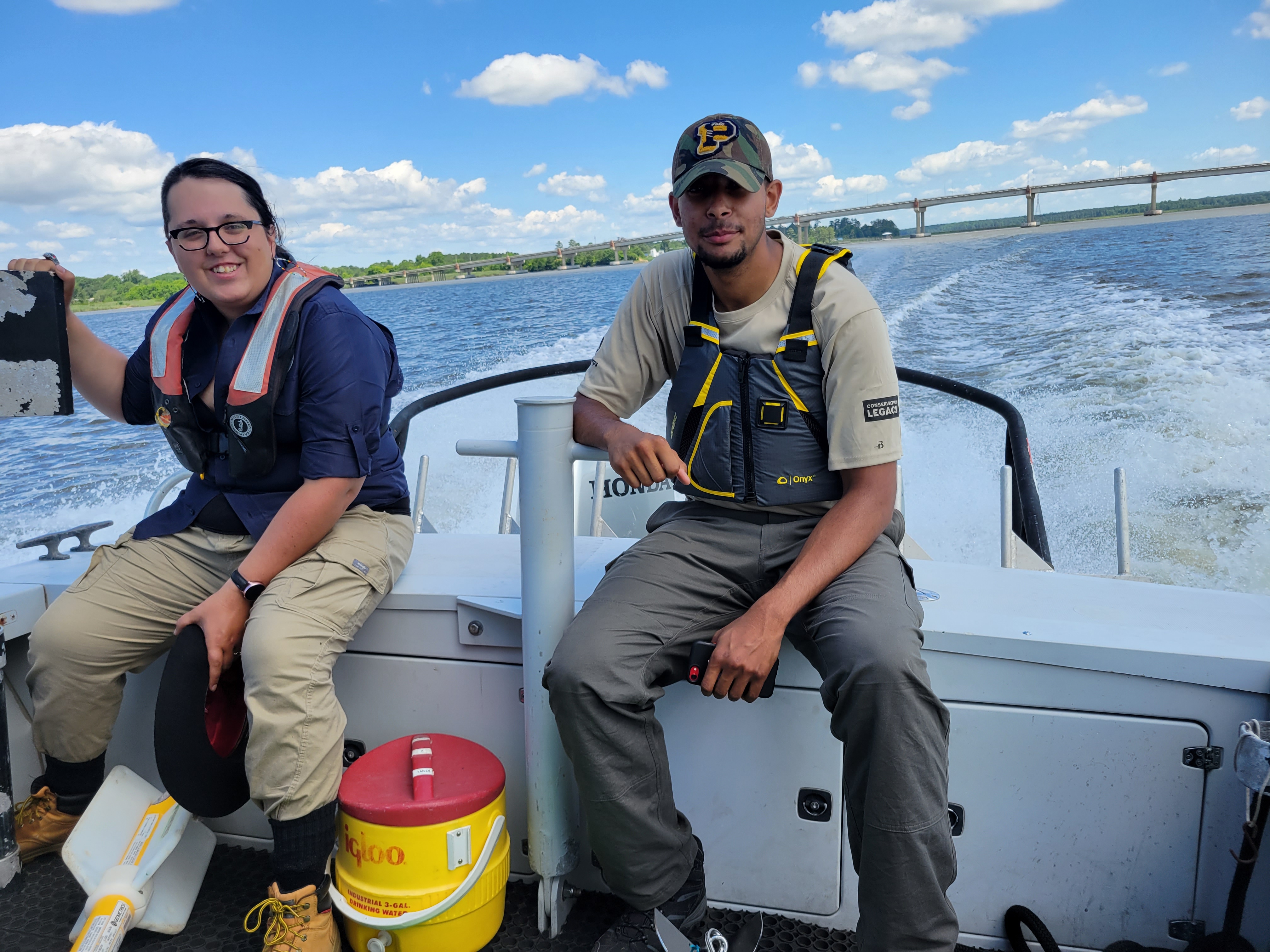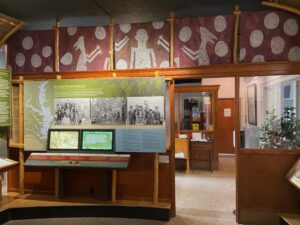The National Park Service provided the following highlights for the Captain John Smith Chesapeake NHT during the 2021 calendar year:
Conserving Trail Lands and Boosting Climate Resilience

Community leaders gather to cut the ribbon on Oyster House Park in Seaford, DE July 1, 2021. Photo by City of Seaford.
In July 2021, Chief Dennis Coker of the Lenape Indian Tribe of Delaware offered a land acknowledgment at the opening of a new park along the Captain John Smith Chesapeake National Historic Trail. Oyster House Park is a new riverside park in Seaford, Delaware. Its planning began in 2018, when the Chesapeake Conservancy purchased the property with the support of the Mt. Cuba Center. The Conservancy donated the waterfront parcel to the City of Seaford.
After a year-long public planning and comment period, community input was incorporated into a draft master plan for the park. In February 2020, the City Council approved a master plan calling for four stages of the park’s construction. The first stage was completed this summer. Subsequent phases are planned to take place over five years. These plans include a natural green amphitheater serving as an outdoor classroom, gathering space for performances, and erosion control to address runoff from steep banks. Also planned is a structure that is a reimagination of the two Oyster Houses that were once on the site that will showcase sculpture, interpretive exhibits and provide meeting space. The final phase will include pedestrian access to the nearby prayer garden and a Tribal ring for the Nanticoke Indians to practice traditional ceremonies.
Collaboration and Engagement

From left, Ancestral Lands Corps individual placements Rihanna Kelver and Kalen Anderson assist an underwater archeology crew at the Werowocomoco archeological site in Gloucester County, Virginia. Photo by Connor Tupponce, Appalachian Conservation Corps.
Chesapeake Trail staff were awarded the Appleman-Judd-Lewis Award for their Ancestral Lands Corps program, the first of its kind in the eastern United States. The Appleman-Judd-Lewis Awards were established in 1970 by the National Park Service to recognize excellence in cultural resource stewardship and management. Connor Tupponce, an individual placement from the inaugural season, returned for the second, 2021 season in the lead position. He provided guidance to the trail’s two 2021 placements, Rihanna Kelver and Kalen Anderson.
The trio was based at Jamestown, the trail’s headquarters, where they worked alongside NPS rangers and staff in four different divisions at the park — Interpretation & Education, Law Enforcement, Facility Management, and Resource Management — in order to become familiar with how the divisions work together and operate within the greater national park system. Each division provided opportunities to apply skills and knowledge to those same operations at Werowocomoco. All three placements have ancestral ties to Werowocomoco, an archeological site managed by the Trail. The three placements also had the opportunity to work alongside several educational and archeological organizations in the community.
The placements concluded their program with presentations to NPS staff and Tribal leaders. In the presentations, they offered recommendations for the future management of Werowocomoco. Ancestral Lands Corps placements earn educational credit as well as direct hiring authority for two years. The trail will continue the program in 2022 and is extending the lead position from a 26-week to a 50-week placement.
Strengthening Organizations and Partnerships

Interior of Gloucester County Visitor Center’s Werowocomoco exhibit, Gloucester, VA 2021. Photo by Remi Shaull-Thompson, Student Conservation Association.
At more than 3,000 miles long, the Chesapeake Trail’s many partners are essential to the Trail’s engagement with the public. In 2021, trail partners across the watershed continued to represent the trail in their programming. In April, the Gloucester County Visitor Center in Gloucester, Virginia opened a new, permanent exhibit on Werowocomoco – a significant American Indian archeological site managed by the Trail. Thanks to a $120,000 grant from NPS, visitors will be treated to a state-of-the-art experience.
Staff from the visitor center collaborated with staff from the Trail and Moser Productions, Inc., a design company based in Richmond, Virginia, to develop the exhibit. An image of Werowocomoco etched in three panels of glass greets visitors, and special features include a video on Werowocomoco that can also be found on the Trail’s website; an interactive timeline of the development of the Virginia Indian tribes, the site itself, and Gloucester County; and a stunning lenticular print image of Pocahontas.
Archeological artifacts from Werowocomoco, on loan from the Virginia Department of Historic Resources, can be found along a wall alongside touchscreens that display the artifacts in 3-D imagery. The touchscreens allow the visitor to “spin” the artifacts around to see all angles. An iconic conjectural image of Werowocomoco can be seen behind the artifacts. It shows an artist’s bird’s-eye view of Werowocomoco around the late 1500s, prior to the arrival of Europeans in present-day Virginia in 1607. Werowocomoco is located just a few miles from Gloucester, making it an ideal location for off-site interpretation while trail staff work to develop a plan for on-site interpretation in the coming years.
Education, Interpretation and Cultural Expression
On June 7, through a task agreement with the Chesapeake Conservancy, the Trail held its second Maritime Crafts Field School. Hosted by the Watermen’s Museum in Yorktown, Va., the field school met on the banks of the York River to explore American Indian maritime technologies of the Chesapeake Bay as well as the potential for cultural education to foster stewardship and understanding in our communities.
Participants included peers from heritage organizations across the watershed, such as the Nansemond Indian Nation, James River Association, Virginia State Parks, and more. The instructor was Michael Steen, director of education for the Watermen’s Museum and a lifelong teacher with 40 years of museum interpretation and education experience. Participants split into groups to work through four stations: burning a dugout canoe, hand-making cordage, constructing fishing nets, and carving stone and bone tools. After lunch, the groups completed two additional stations: seining and fishing tools. The day concluded with a recap of what had been learned and ideas for increasing stewardship of the Bay at our respective sites.
A film crew was on site recording the lessons, and videos were produced that were shared on the trail’s website and social media pages. You can view those recordings here: nps.gov/cajo/learn/photosmultimedia/maritime-crafts.htm
Other Highlights
Werowocomoco is a significant American Indian archeological site located on the north bank of the York River in Gloucester County, Virginia. The Chesapeake Trail manages Werowocomoco and is developing plans for the site’s opening in cooperation with Tribal nations. Archeology was conducted previously on the site within a limited geographical area. In order to fully understand the extent of the archeology beneath the surface of the soil, additional surveys are required.
The Chesapeake Conservancy and NPS staff worked together to develop a scope of work for a geophysical survey. The project will employ two forms of geophysical survey methods – ground-penetrating radar and magnetic gradient survey — over 55 acres of the property. These methods use radars and sensors to reveal subsurface features without the need to dig or otherwise disturb the soil.
The Chesapeake Conservancy sent out a request for proposals in order to hire an experienced archeologist to complete the survey. The Conservancy and the NPS reviewed the proposals, and the Conservancy made the final selection of Horsley Archaeological Prospection, LLC (HAP). The NPS and the Chesapeake Conservancy then held a kickoff meeting with HAP. They expect fieldwork to begin this winter.
Before fieldwork begins, HAP will hold workshops for Tribal nations in geophysical survey techniques. A final report, which will provide insight into the distribution and extent of archeological features, is slated to be completed by September 2022. The information revealed in the report will prove invaluable as trail staff plan for the site’s future, work to protect archeological resources, and interpret the site to the public.